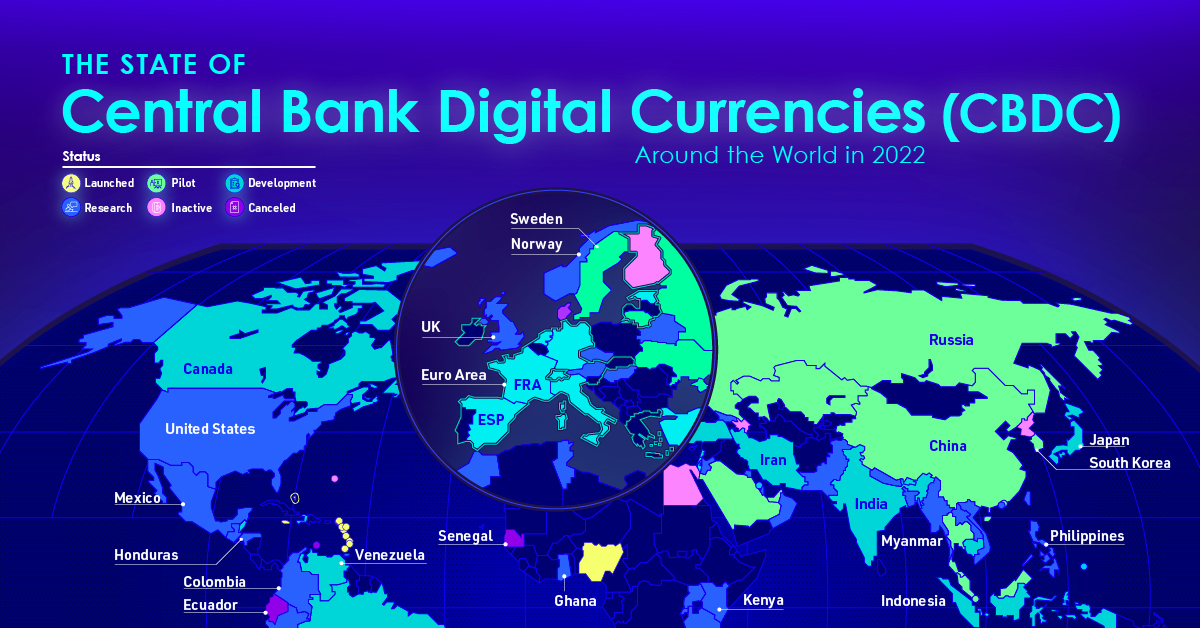Technology
Visualized: The State of Central Bank Digital Currencies
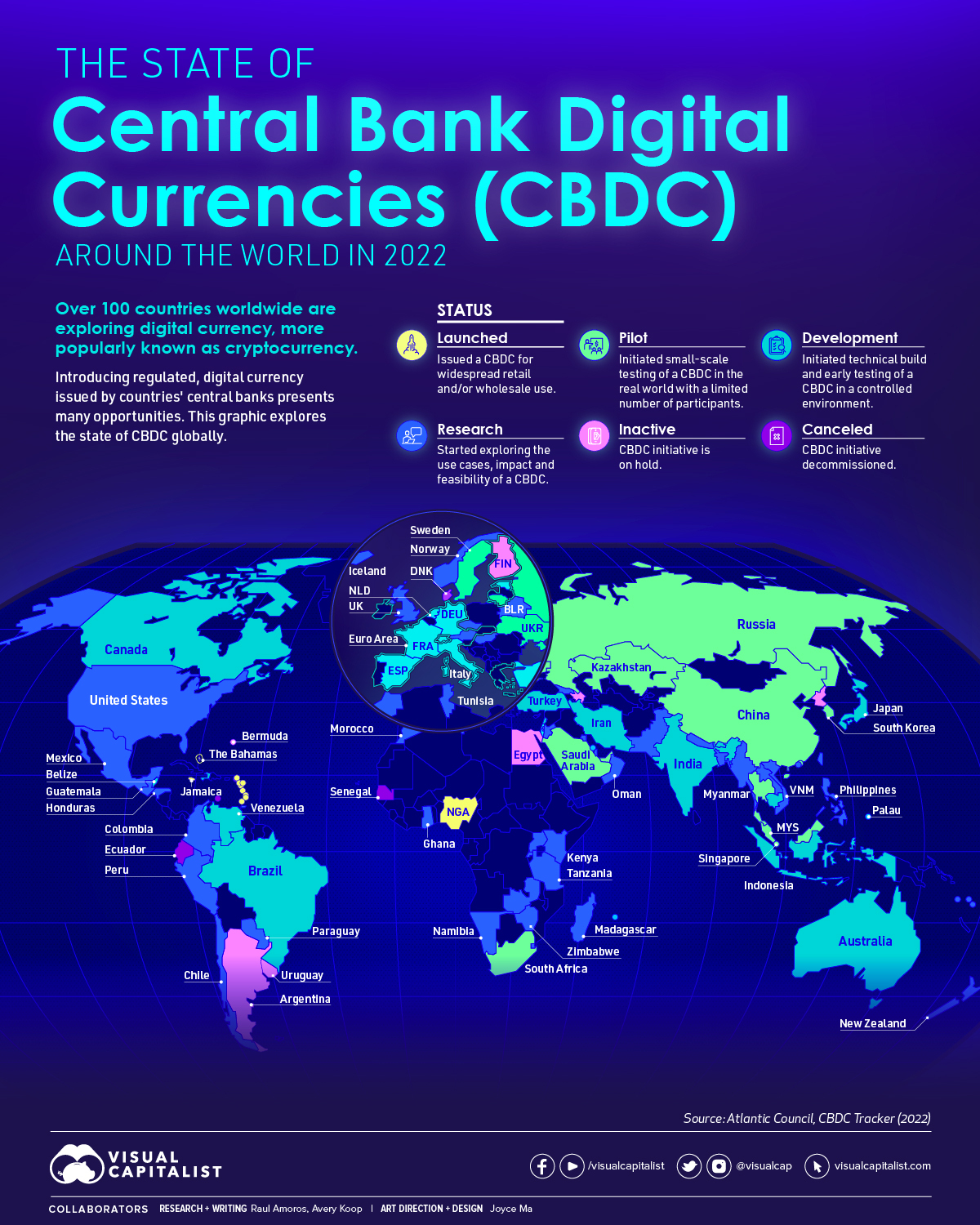
Visualized: The State of Central Bank Digital Currencies
Central banks around the world are getting involved in digital currencies, but some are further ahead than others.
In this map, we used data from the Atlantic Council’s Currency Tracker to visualize the state of each central banks’ digital currency effort.
Digital Currency – The Basics
Digital currencies have been around since the 1980s, but didn’t become widely popular until the launch of Bitcoin in 2009. Today, there are thousands of digital currencies in existence, also referred to as “cryptocurrencies”.
A defining feature of cryptocurrencies is that they are based on a blockchain ledger. Blockchains can be either decentralized or centralized, but the most known cryptocurrencies today (Bitcoin, Ethereum, etc.) tend to be decentralized in nature. This makes transfers and payments very difficult to trace because there is no single entity with full control.
Government-issued digital currencies, on the other hand, will be controlled by a central bank and are likely to be easily trackable. They would have the same value as the local cash currency, but instead issued digitally with no physical form.
Central Bank Digital Currencies Worldwide
105 countries are currently exploring centralized digital currencies. Together, they represent 95% of global GDP. The table below lists the data used in the infographic.
| Country | Status | Use Case |
|---|---|---|
| Nigeria | Launched | Retail |
| The Bahamas | Launched | Retail |
| Jamaica | Launched | Retail |
| Anguila | Launched | Retail |
| Saint Kitts and Nevis | Launched | Retail |
| Antigua and Barbuda | Launched | Retail |
| Montserrat | Launched | Retail |
| Dominica | Launched | Retail |
| Saint Lucia | Launched | Retail |
| Saint Vincent and the Grenadines | Launched | Retail |
| Grenada | Launched | Retail |
| Sweden | Pilot | Retail |
| Lithuania | Pilot | Retail |
| Ukraine | Pilot | Undecided |
| Kazakhstan | Pilot | Retail |
| Russia | Pilot | Retail |
| China | Pilot | Both |
| Thailand | Pilot | Both |
| Hong Kong | Pilot | Both |
| South Korea | Pilot | Retail |
| Saudi Arabia | Pilot | Wholesale |
| United Arab Emirates | Pilot | Wholesale |
| Singapore | Pilot | Wholesale |
| Malaysia | Pilot | Wholesale |
| South Africa | Pilot | Both |
| Canada | Development | Both |
| Belize | Development | Undecided |
| Haiti | Development | Both |
| Venezuela | Development | Both |
| Brazil | Development | Retail |
| Turkey | Development | Retail |
| Iran | Development | Retail |
| Bahrain | Development | Wholesale |
| India | Development | Both |
| Mauritius | Development | Both |
| Bhutan | Development | Both |
| Cambodia | Development | Retail |
| Indonesia | Development | Both |
| Palau | Development | Both |
| Australia | Development | Both |
| Japan | Development | Both |
| Spain | Development | Retail |
| France | Development | Both |
| Netherlands | Development | Retail |
| Switzerland | Development | Wholesale |
| Italy | Development | Undecided |
| Germany | Development | Undecided |
| Estonia | Development | Retail |
| Lebanon | Development | Retail |
| Israel | Development | Retail |
| Euro Area | Development | Both |
| United States | Research | Retail |
| Mexico | Research | Retail |
| Guatemala | Research | Undecided |
| Honduras | Research | Undecided |
| Trinidad andd Tobago | Research | Undecided |
| Colombia | Research | Undecided |
| Peru | Research | Undecided |
| Paraguay | Research | Undecided |
| Chile | Research | Retail |
| Iceland | Research | Retail |
| UK | Research | Both |
| Morocco | Research | Retail |
| Ghana | Research | Retail |
| Namibia | Research | Undecided |
| Eswatini | Research | Both |
| Madagastar | Research | Retail |
| Zimbabwe | Research | Undecided |
| Zambia | Research | Undecided |
| Tanzania | Research | Undecided |
| Rwanda | Research | Undecided |
| Uganda | Research | Undecided |
| Kenya | Research | Retail |
| Tunisia | Research | Wholesale |
| Oman | Research | Undecided |
| Kuwait | Research | Retail |
| Jordan | Research | Undecided |
| Georgia | Research | Retail |
| Belarus | Research | Undecided |
| Norway | Research | Retail |
| Czech Republich | Research | Undecided |
| Pakistan | Research | Retail |
| Nepal | Research | Undecided |
| Bangladesh | Research | Undecided |
| Myanmar | Research | Undecided |
| Laos | Research | Both |
| Vietnam | Research | Undecided |
| Macau | Research | Undecided |
| Taiwan | Research | Both |
| Philippines | Research | Retail |
| New Zealand | Research | Retail |
| Vanuatu | Research | Undecided |
| Fiji | Research | Undecided |
| Tonga | Research | Undecided |
| Palestine | Research | Retail |
| Jordan | Research | Undecided |
| Austria | Research | Wholesale |
| Hungary | Research | Retail |
| Bermuda | Inactive | Undecided |
| Sint Maarten | Inactive | Retail |
| Curaçao | Inactive | Retail |
| Argentina | Inactive | Undecided |
| Uruguay | Inactive | Retail |
| Denmark | Inactive | Retail |
| Azerbaijan | Inactive | Undecided |
| Egypt | Inactive | Undecided |
| North Korea | Inactive | Undecided |
| Finland | Inactive | Retail |
| Ecuador | Cancelled | Retail |
| Senegal | Cancelled | Retail |
When aggregated, we can see that the majority of countries are in the research stage.
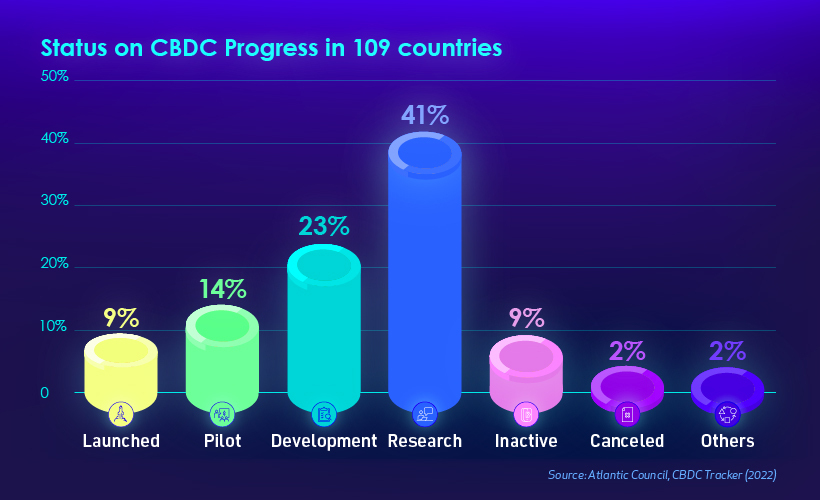
We’ve also divided the map by region to make viewing easier.
Africa
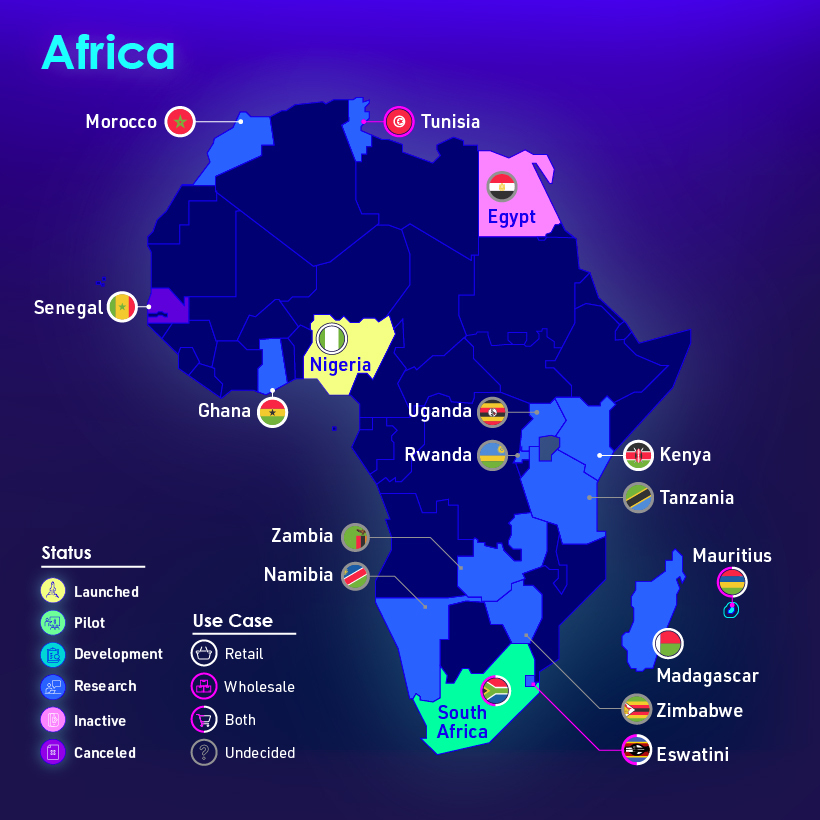
Asia
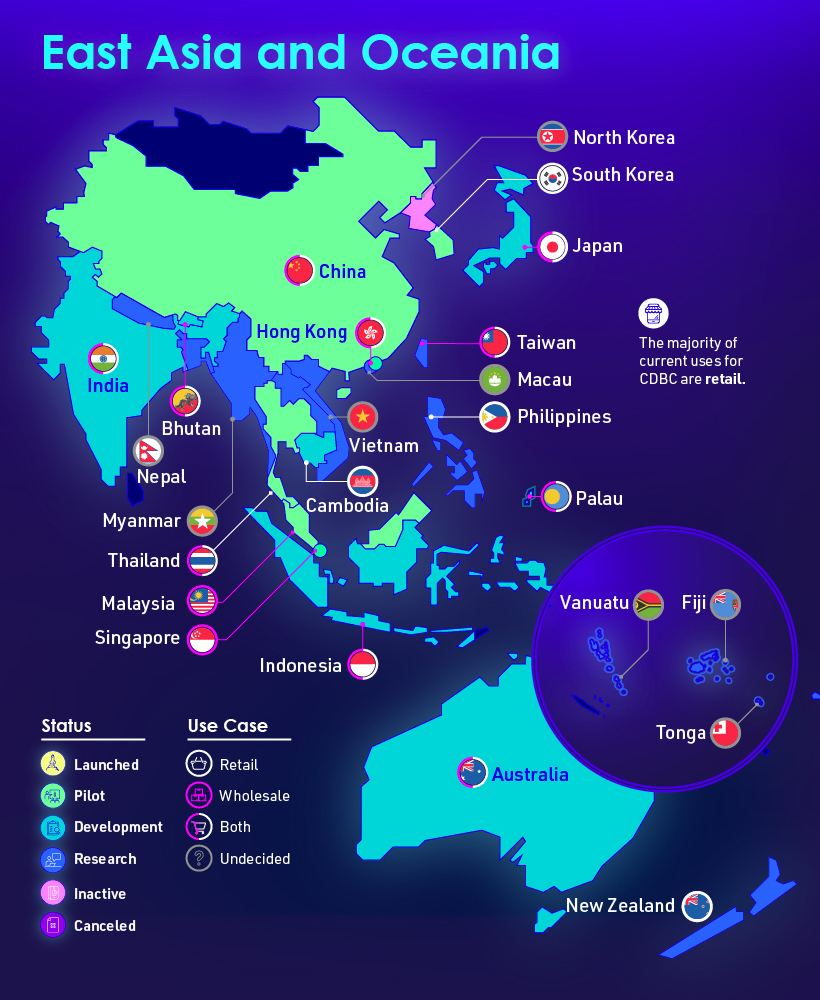
Europe
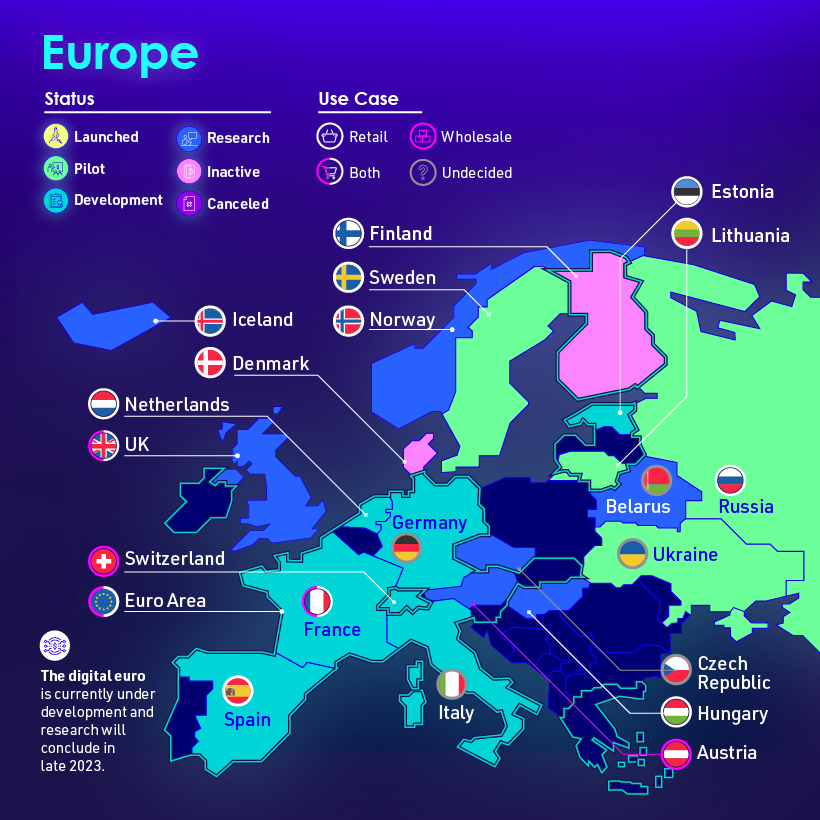
Middle East
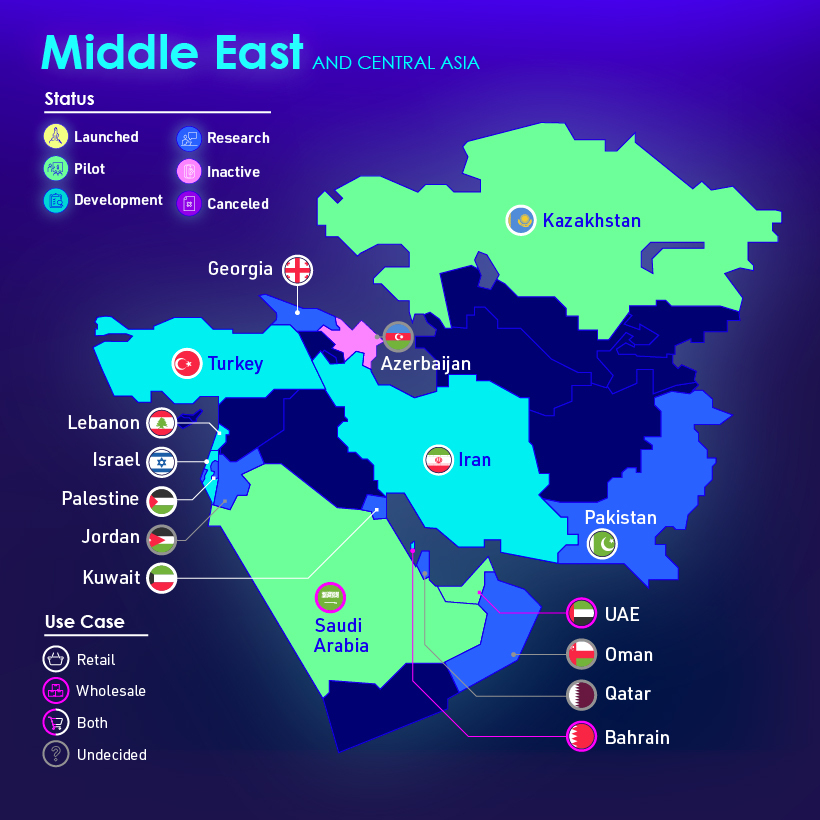
South America
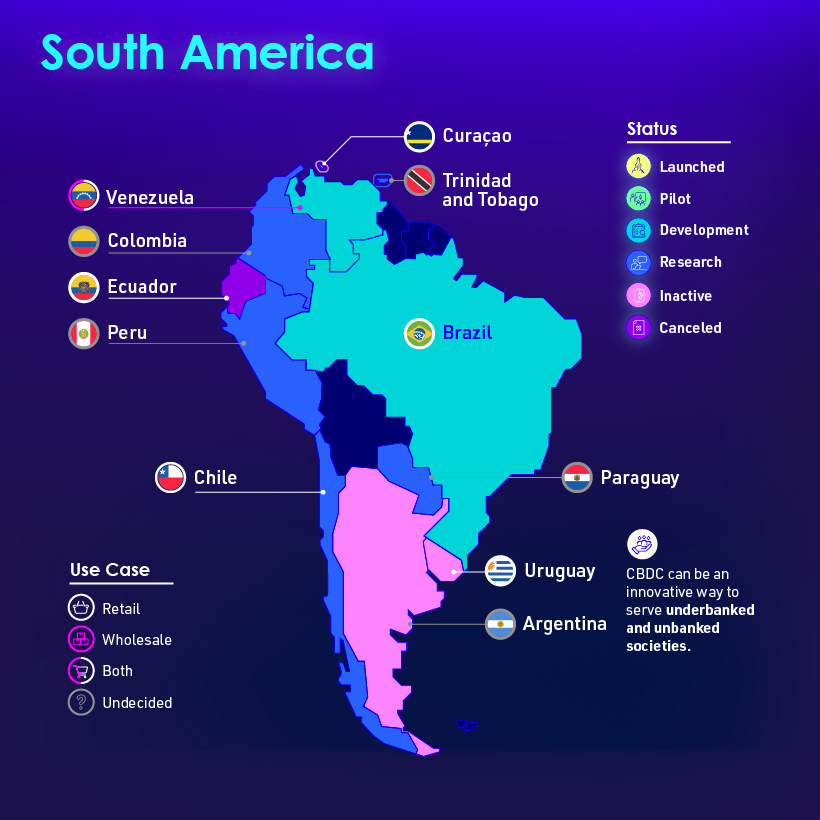
North America
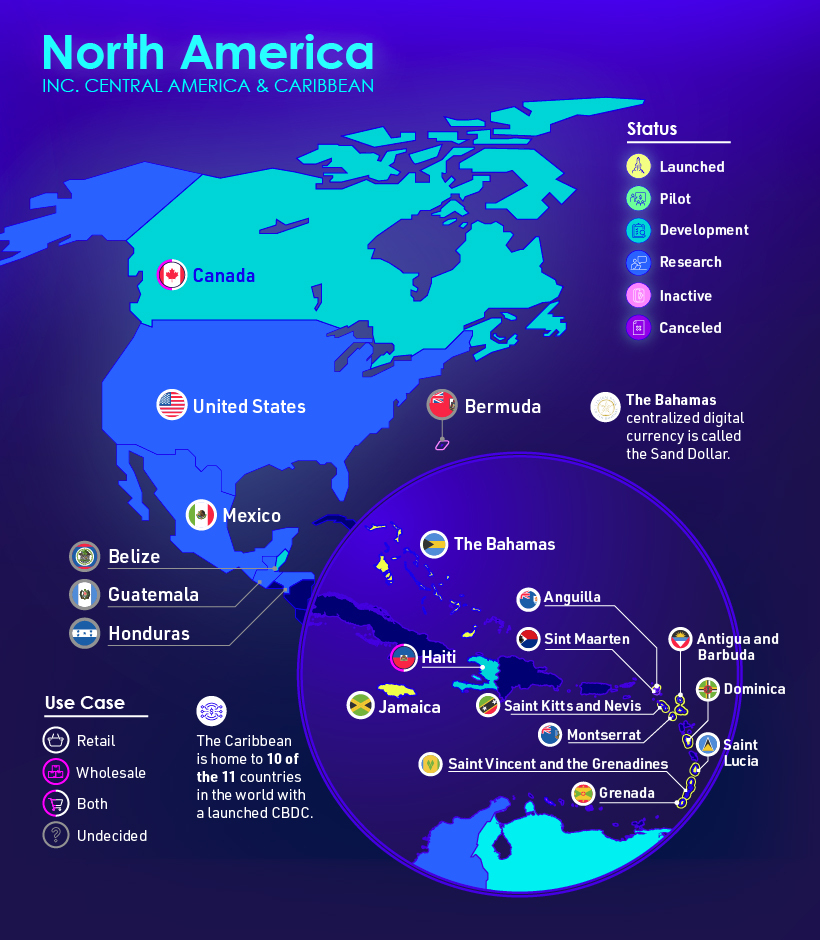
What are the Benefits?
A major benefit of government-issued digital currencies is that they can improve access for underbanked people.
This is not a huge issue in developed countries like the U.S., but many people in developing nations have no access to banks and other financial services (hence the term underbanked). As the number of internet users continues to climb, digital currencies represent a sound solution.
To learn more about this topic, visit this article from Global Finance, which lists the world’s most underbanked countries in 2021.
The 9%
Just 9% of countries have launched a digital currency to date.
This includes Nigeria, which became the first African country to do so in October 2021. Half of the country’s 200 million population is believed to have no access to bank accounts.
Adoption of the eNaira (the digital version of the naira) has so far been relatively sluggish. The eNaira app has accumulated 700,000 downloads as of April 2022. That’s equal to 0.35% of the population, though not all of the downloads are users in Nigeria.
Conversely, 33.4 million Nigerians were reported to be trading or owning crypto assets, despite the Central Bank of Nigeria’s attempts to restrict usage.
Status in the U.S.
America’s central bank, the Federal Reserve, has not decided on whether it will implement a central bank digital currency (CBDC).
Our key focus is on whether and how a CBDC could improve on an already safe and efficient U.S. domestic payments system.
– Federal Reserve
To learn more, check out the Federal Reserve’s January 2022 paper on the pros and cons of CBDCs.
Technology
Visualizing AI Patents by Country
See which countries have been granted the most AI patents each year, from 2012 to 2022.

Visualizing AI Patents by Country
This was originally posted on our Voronoi app. Download the app for free on iOS or Android and discover incredible data-driven charts from a variety of trusted sources.
This infographic shows the number of AI-related patents granted each year from 2010 to 2022 (latest data available). These figures come from the Center for Security and Emerging Technology (CSET), accessed via Stanford University’s 2024 AI Index Report.
From this data, we can see that China first overtook the U.S. in 2013. Since then, the country has seen enormous growth in the number of AI patents granted each year.
| Year | China | EU and UK | U.S. | RoW | Global Total |
|---|---|---|---|---|---|
| 2010 | 307 | 137 | 984 | 571 | 1,999 |
| 2011 | 516 | 129 | 980 | 581 | 2,206 |
| 2012 | 926 | 112 | 950 | 660 | 2,648 |
| 2013 | 1,035 | 91 | 970 | 627 | 2,723 |
| 2014 | 1,278 | 97 | 1,078 | 667 | 3,120 |
| 2015 | 1,721 | 110 | 1,135 | 539 | 3,505 |
| 2016 | 1,621 | 128 | 1,298 | 714 | 3,761 |
| 2017 | 2,428 | 144 | 1,489 | 1,075 | 5,136 |
| 2018 | 4,741 | 155 | 1,674 | 1,574 | 8,144 |
| 2019 | 9,530 | 322 | 3,211 | 2,720 | 15,783 |
| 2020 | 13,071 | 406 | 5,441 | 4,455 | 23,373 |
| 2021 | 21,907 | 623 | 8,219 | 7,519 | 38,268 |
| 2022 | 35,315 | 1,173 | 12,077 | 13,699 | 62,264 |
In 2022, China was granted more patents than every other country combined.
While this suggests that the country is very active in researching the field of artificial intelligence, it doesn’t necessarily mean that China is the farthest in terms of capability.
Key Facts About AI Patents
According to CSET, AI patents relate to mathematical relationships and algorithms, which are considered abstract ideas under patent law. They can also have different meaning, depending on where they are filed.
In the U.S., AI patenting is concentrated amongst large companies including IBM, Microsoft, and Google. On the other hand, AI patenting in China is more distributed across government organizations, universities, and tech firms (e.g. Tencent).
In terms of focus area, China’s patents are typically related to computer vision, a field of AI that enables computers and systems to interpret visual data and inputs. Meanwhile America’s efforts are more evenly distributed across research fields.
Learn More About AI From Visual Capitalist
If you want to see more data visualizations on artificial intelligence, check out this graphic that shows which job departments will be impacted by AI the most.
-

 Mining1 week ago
Mining1 week agoGold vs. S&P 500: Which Has Grown More Over Five Years?
-

 Markets2 weeks ago
Markets2 weeks agoRanked: The Most Valuable Housing Markets in America
-

 Money2 weeks ago
Money2 weeks agoWhich States Have the Highest Minimum Wage in America?
-

 AI2 weeks ago
AI2 weeks agoRanked: Semiconductor Companies by Industry Revenue Share
-

 Markets2 weeks ago
Markets2 weeks agoRanked: The World’s Top Flight Routes, by Revenue
-

 Countries2 weeks ago
Countries2 weeks agoPopulation Projections: The World’s 6 Largest Countries in 2075
-

 Markets2 weeks ago
Markets2 weeks agoThe Top 10 States by Real GDP Growth in 2023
-

 Demographics2 weeks ago
Demographics2 weeks agoThe Smallest Gender Wage Gaps in OECD Countries




